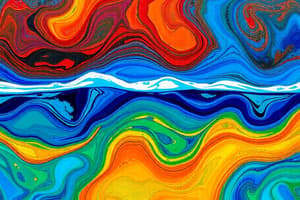Podcast
Questions and Answers
Apa yang dimaksud dengan prediksi pasang surut?
Apa yang dimaksud dengan prediksi pasang surut?
Organisme laut seperti plankton banyak yang terpengaruh oleh arus laut karena...
Organisme laut seperti plankton banyak yang terpengaruh oleh arus laut karena...
Apa manfaat kehadiran plankton dan ikan anchovy terhadap sirkulasi oseanik dan siklus karbon?
Apa manfaat kehadiran plankton dan ikan anchovy terhadap sirkulasi oseanik dan siklus karbon?
Mengapa studi mendalam tentang komponen-komponen di lingkungan laut penting bagi manusia?
Mengapa studi mendalam tentang komponen-komponen di lingkungan laut penting bagi manusia?
Signup and view all the answers
Bagaimana organisme laut seperti plankton dan anchovy berinteraksi dengan sistem arus laut?
Bagaimana organisme laut seperti plankton dan anchovy berinteraksi dengan sistem arus laut?
Signup and view all the answers
Study Notes
Exploring Dynamics of our Watery World: Hydosphere's Components
The hydrosphere is Earth's water reservoir, consisting primarily of oceans, lakes, rivers, icecaps, and groundwater. Delving into its dynamics uncovers fascinating phenomena that shape aquatic environments and influence global processes. Let's explore four key components: ocean currents, water cycles, waves, and marine life.
Ocean Currents
At scale spanning continents, these movements are driven by several factors—wind, temperature variations, salinity differences, and Coriolis effect due to Earth's rotation. As currents flow along, they transport heat, nutrients, and vast amounts of water mass across oceans. By studying them, we better understand climate patterns like El Niño and La Niña.
Water Cycle
This ongoing process involves evaporation from the ocean surface, precipitation onto land, infiltration into soil, and runoff back into bodies of water. Essential for regulating climates worldwide, it shapes weather systems, moderates temperatures, and supports ecosystems through freshwater delivery.
Waves
Energy transfer between air and sea produces waves—rolling motions created by wind blowing over the surface. Wave behaviors such as refraction, diffraction, and interference are crucial aspects of understanding coastal engineering challenges and extreme events like tsunamis.
Tides
Caused by gravitational pull from Sun and Moon, tides create periodic rises and falls in sea level along coastlines. Tide prediction helps guide shipping schedules, maintain harbor safety, and manage aquaculture activities.
Marine Life
Life thrives within the complex interplay among abovementioned forces. Marine organisms live alongside wave action, experience tidal fluctuations, and navigate current systems to find food and suitable habitats. For instance, plankton drifts with prevailing currents while anchovies swim against strong upwellings to feed. In turn, their presence influences oceanic circulation and the carbon cycle.
Through close examination of each component, humanity can develop strategies to mitigate threats and capitalize upon opportunities. Studies fostering deeper comprehension are essential if we wish to address issues concerning sustainable resource management, environmental conservation efforts, and adaptation to climate change impacts.
Studying That Suits You
Use AI to generate personalized quizzes and flashcards to suit your learning preferences.
Description
Dive into the dynamics of Earth's water reservoir, the hydrosphere, by exploring key components such as ocean currents, water cycles, waves, and marine life. Learn how these phenomena shape aquatic environments, impact global processes, and contribute to climate patterns like El Niño and La Niña.




